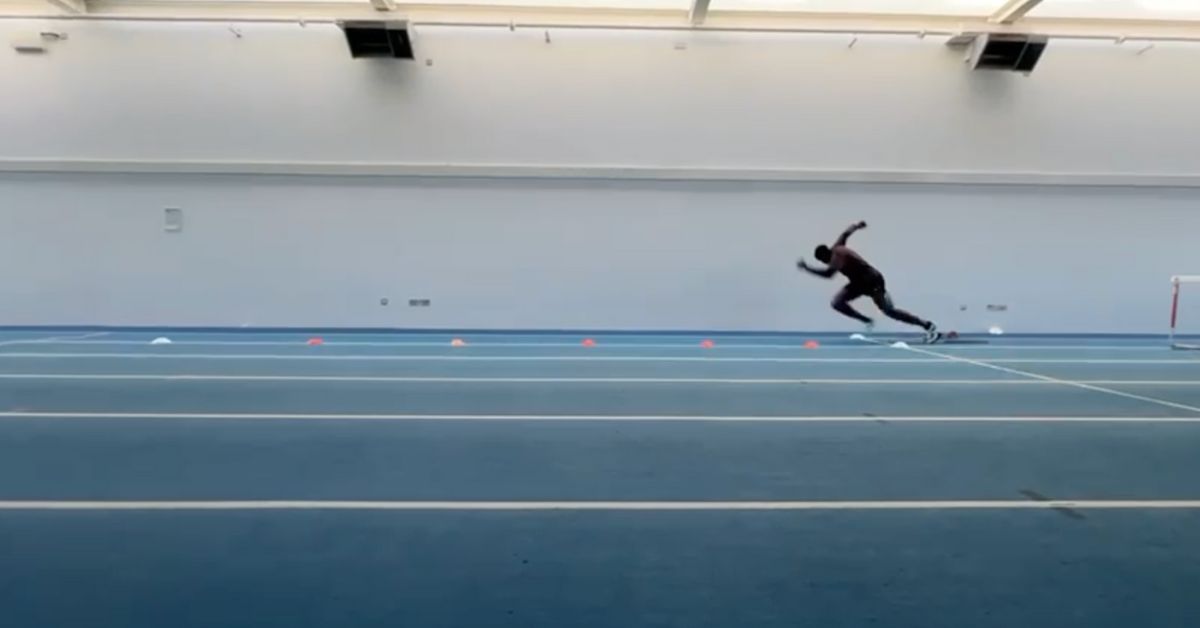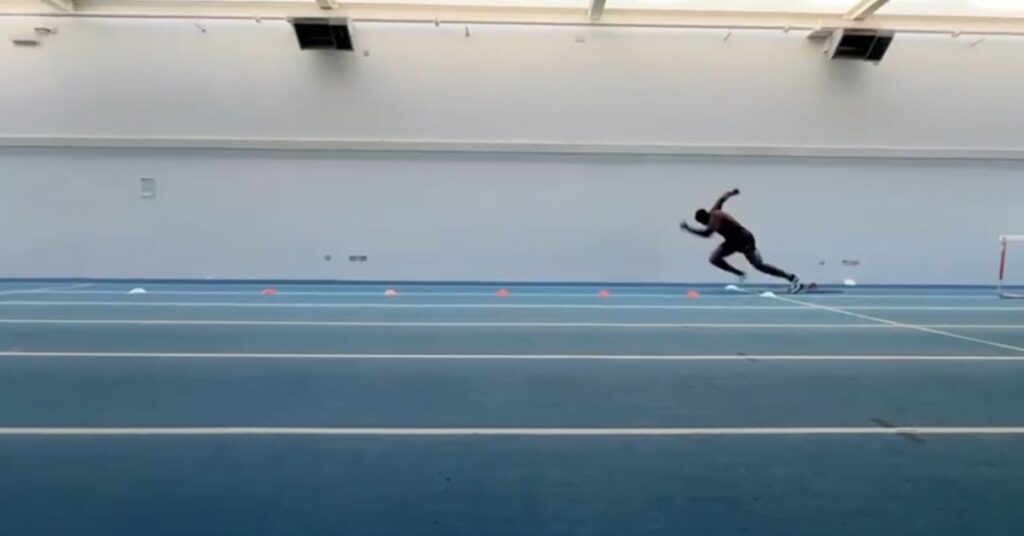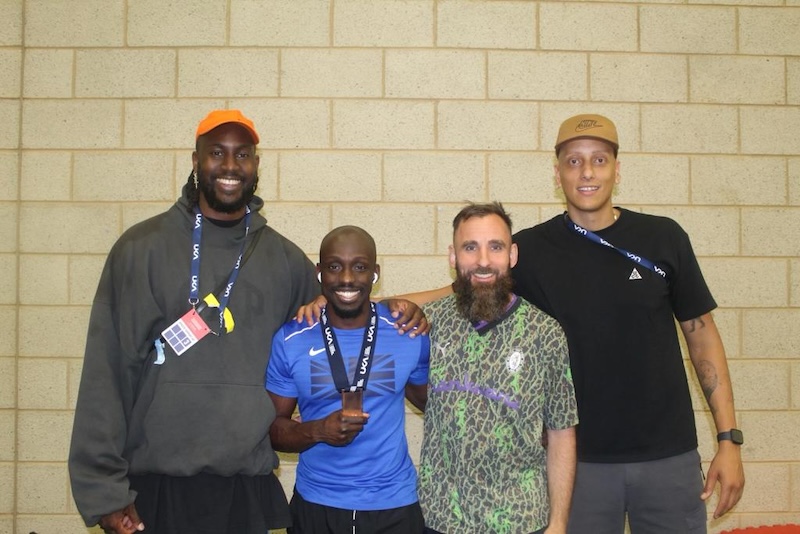

Steve Fudge is the Head Coach of FudgeLdnProject, knowledgeable sprints group situated on the Lee Valley Athletics Heart in London. He makes a speciality of individualized observe teaching complemented by world-class remedy and bodily preparation. With a profession spanning greater than 15 years as a dash coach, Steve has guided athletes to spectacular milestones, together with Sub 10, Sub 20, Olympic, Paralympic, World, European, Asian, and Commonwealth medals. Past teaching, Steve actively contributes to the teaching neighborhood by offering mentorship to aspiring coaches worldwide.
Freelap USA: You entered dash teaching from a extra normal energy and conditioning background. What did that have give you that you could be in any other case have missed?
Steve Fudge: As a energy and conditioning coach, you be taught anatomy, programming, train completely different teams, and many others., all as a part of a multidisciplinary group working with the sport-specific coach and the medical group, amongst others. This expertise allowed me to be taught what sort of setting I wished to work in, and I discovered that I most popular working with smaller teams and in particular person sports activities. As an S&C coach, I felt my job was basically to develop athletes who have been resilient and had the capability to hold out the sport-specific head coach’s programming.
As an S&C coach, I felt my job was essentially to develop athletes who were resilient and had the capacity to carry out the sport-specific head coach’s programming. Click To Tweet
I believe this expertise demonstrated to me that it was the sport-specific coach who would make or break the athlete by way of success, and subsequently, their programming must be completely proper! The S&C coach helps this by creating athletes who’re in a position to perform higher-quality sport-specific follow reps and do extra of them. Facets corresponding to energy across the hips and an anatomy that enables the athlete to keep up the right posture can serve to raise the efficacy of the sport-specific coaching.
I discovered the worth of constructing a powerful relationship with the sport-specific coach, so I might perceive what was wanted from me as an S&C coach and the way greatest to work with the athletes. A selected instance of this may be that, as an S&C coach, I discovered my sequencing from normal to particular wanted to happen a bit sooner than it did for the sport-specific coaching.
Primarily, I used to be making ready the athletes for the upcoming part of sports-specific coaching, so I had to offer them with some publicity to the form of stimulus they might anticipate of their upcoming coaching block and set them up with the qualities they wanted in order that they may reap the benefits of the sport-specific work. For instance, if I do know the athletes are about to enter a six- to eight-week block the place high-velocity sprinting is the principle focus, I wish to make sure that I’ve developed their energy and elasticity previous to that to allow them to maximize the profit from the high-velocity coaching block.
Video 1. British sprinter Eugene Amo Dadzie coaching in an outside session.
Moreover, as an S&C coach, you wish to make sure that there’s no interference between the work you’re prescribing the athlete and the sport-specific work they’re doing. In the event that they’re doing significantly neurally demanding work on the observe, then any neurally demanding work within the weight room would doubtless must be restricted.
Freelap USA: You’re fairly well-known for educating technical ideas to your sprinters. I’m positive the strategies you utilize to information the athletes towards the positions you wish to see differ, however what ideas and positions do you see as integral to a excessive stage of dash efficiency?
Steve Fudge: What I’m searching for in a 100-meter sprinter is an athlete who strikes down the observe in or round 45 steps. Inside every of these steps, they should have a lengthening second and a folding second, and this sequence must be carried out in such a approach that it doesn’t disrupt their momentum. Subsequently, every floor contact must be impactful, however after that contact, the athlete must rearrange their positions so their subsequent floor contact will also be impactful.
Video 2. Eugene Amo Dadzie’s acceleration posture.
One of many largest challenges is that the athlete must strike the bottom onerous, and there must be a second the place the hip, knee, and ankle all violently lengthen. Nonetheless, to maintain momentum, the athlete can’t spend too lengthy lengthening, as it can gradual issues down by probably bringing the shoulders again and forcing a touchdown that generates larger braking forces.
One of the things I think the best ‘top-end’ sprinters do well is consistently keep the action in the space just in front of them. Click To Tweet
This could have a knock-on impact of disrupting the rhythm and inflicting the athlete to pressure frequency. Subsequently, there’s the necessity to get the leg again in entrance, virtually a triple-flexion second, in preparation for the subsequent step. One of many issues I believe one of the best “top-end” sprinters do properly is persistently preserve the motion within the area simply in entrance of them. It seems one of the best have the flexibility to pre-program their posture to make sure that every step is related, they usually do a superb job of rearranging their shapes after the earlier contact to make sure they’re prepared for the subsequent.
Sprinting could be very a lot a balancing act and must be harmonic. Elite sprinters have excessive velocities as a result of they’ve excessive frequencies, which is what occurs within the air, they usually have excessive velocities as a result of they’ve lengthy stride lengths, which is a results of what occurs on the bottom. As a sprinter, we would like each these metrics to be excessive, and it may be considerably paradoxical as a result of emphasizing one will rob the opposite.
One of many issues I search for to make sure that frequency isn’t rushed and there’s sufficient time for stride size to be generated is that when the foot is on the bottom, the pelvis should go over the foot. After this level, the job is already completed, and the athlete can get well the leg, “transfer to the entrance,” and arrange for the subsequent contact. If there’s an excessive amount of emphasis on extension, the athlete can discover themselves in a state of affairs the place they don’t have sufficient time on the entrance to arrange the subsequent step, and the rhythm can break.
Freelap USA: Know-how is changing into increasingly more accessible to dash coaches to each develop and observe efficiency. What applied sciences do you utilize when making ready your sprinters?
Steve Fudge: As coaches, we adapt to our state of affairs, whether or not that be with or with out a lot entry to expertise. I’ve gone by one stage of my profession the place I had good entry to expertise, and we obtained good outcomes. After I was based mostly in Loughborough and dealing for British Athletics, we had entry to OptoJump and Laveg—each instruments that might present immediate suggestions all through the dash session.
The knowledge could possibly be used to bolster what I noticed, and I attempted to mix the metrics with mechanics and the coach’s eye, which is the place I see the implementation of expertise as being most dear. For instance, I’ll detect a change in rhythm at “x” meters right into a run, and the info could present that there was a change in stride size and stride frequency at that very same level as properly, or there was a plateau in acceleration. This, subsequently, helped to information the method and enabled us to be extra assured about which level within the run we would have liked to work on.
We might use the Laveg as a technique to information and assess the session goal. For instance, I might ask an athlete to construct to a prime pace at 65 meters, and the Laveg would assist us decide whether or not that goal was met. It additionally allowed the athlete to equate what profitable completion of the train felt like.
Nonetheless, in my present state of affairs—a personal, impartial group with no federation help or sponsorship— we’ve got little or no expertise however nonetheless get good outcomes. I at the moment use a whistle, a stopwatch, an overspeed band, and the digital camera app on my iPhone!
Video 3. British 100m sprinter Ojie Edoburun sprints from the whistle.
Know-how is barely nearly as good because the practitioner, and as with many issues, the knowledge is barely as worthwhile as your interpretation. Subsequently, I believe expertise can improve good teaching, however with out that and efficient programming, I don’t suppose expertise alone can do one of the best job.
Technology is only as good as the practitioner, and as with many things, the information is only as valuable as your interpretation… I worry that too much data may interfere with my intuition. Click To Tweet
I believe there’s a danger in implementing expertise you don’t persistently have entry to as a result of it solely offers a snapshot of the entire image. This will likely trigger you to panic unnecessarily based mostly upon what is actually an anomaly, however you’re unable to see that with out the presence of constant knowledge. The danger is that now the coach overhauls this system and begins heading in a special metaphorical route.
Knowledge may be helpful, however there’s a danger that an excessive amount of knowledge can intervene with my instinct or trigger me to overthink issues. Now, I don’t suppose that is the case for each coach, so it’s necessary for a coach to determine which items of knowledge they consider to be necessary. Then, they should go about guaranteeing they’ll entry that data to information their decision-making. In the end, a lot as each athlete is completely different, each coach is completely different, and they should spend time creating their very own approach of doing issues.
As coaches, we have to make plenty of choices, and generally in high-pressure situations. Subsequently, it’s necessary to construct a system that athletes have belief in and never simply copy what another person does, as they might not have confronted the identical state of affairs that you simply’re in at the moment.
Freelap USA: I’ve heard you discuss a “well being first” strategy when teaching your athletes. Are you able to elaborate on the sensible purposes of this in your day-to-day follow? Are you able to present an instance of individualizing your programming to advertise this philosophy?
Steve Fudge: It’s essential to get the programming proper! We have now the occasions we have to put together for, and we’ve got the people in entrance of us. It may be a problem as a result of it is advisable to have a look at the individual, then have a look at the “excellent” program you’ll implement to arrange somebody to run that occasion, after which determine a technique to marry the 2 collectively.
If you wish to keep wholesome (which it’s best to!), it is advisable to choose the proper sort of coaching for that particular person, then tempo and progress it appropriately. As I stated, basically, the programming must be applicable.
If I’ve a 60–100-meter sort athlete, I sit down and map out the kind of work, periods, and progressions I believe they should do by normal prep, particular prep, and into the aggressive part. I then have a look at the athlete and determine what I must make that program work. The place does this system must be trimmed or edited so it’s nonetheless that program however now suits the person?
It could possibly virtually be a case of becoming a spherical peg right into a sq. gap, so it’s difficult! This may be assisted by having common entry to an excellent therapist and an excellent group to help with prehab and rehab, but when the programming is off, none of that actually issues.

We then want to bear in mind what have to be completed each day to stay on that pathway. If you find yourself in a state of affairs the place what you’ve gotten deliberate for a given day now not appears applicable, it is advisable to be versatile and make an excellent resolution, and this requires self-discipline. It could possibly be one thing just like the athlete didn’t sleep properly or a household problem has arisen, and it’s necessary to know that the entire plan gained’t collapse as a result of this session isn’t completed on a specific day.
Staying on the trail, maybe paradoxically, requires you to be open-minded and alter the plan as you go in some circumstances. I believe it was Mike Tyson who stated that everybody has a plan till they get punched within the face, and as coaches, all of us have plans till we meet our athletes and understand they’re human beings, not robots!
Freelap USA: As we’ve talked about, your programming may be fairly individualized based mostly on what you see from the athlete. Are you able to present a normal guideline of the way you set out your coaching week and a few examples to reveal what this seems like in follow?
Steve Fudge: In my expertise, inside normal prep, periods typically match a pleasant, tidy association, however as soon as we get to particular prep, issues get extra chaotic, and I must be extra adaptable.
Basically prep, although, we’ll have 4 technical items, 4 tempo items, and 4 health club items inside every week. Whereas the main points could differ fairly considerably relying on a number of elements corresponding to time of yr, well being standing, athlete profiling, and many others., that is an instance of what some periods could seem like for an athlete.
Video 4. Indoor coaching session with Eugene Amo Dadzie.
Monday:
Acceleration – 6–8×20–30m from numerous stances, corresponding to ranging from one block pedal.
Brief tempo – 4x2x50m back-to-backs, 1–2 minutes’ relaxation.
Health club – Conditioning and capability (much less neurally intense; centered on motion patterns and conditioning).
Tuesday:
Transition – 4–6×35–50m over cones with a few 10-meter run-in. (I need six steps earlier than the athlete reaches the primary cone.).
Lengthy tempo – 220m+110m, 200m+110m, 150m+110m.
Health club – Pressure and normal energy (conventional energy, energy, and elastic work).
Wednesday:
Off
Thursday:
Acceleration – Just like Monday.
Common health tempo – Individualized relying on what I believe that athlete wants.
Health club – Conditioning and capability (see Monday).
Friday:
Upright working – 2–4x55m over cones with an 18-meter run-in.
Medium tempo – 180m, relaxation 6 minutes, 150m, relaxation 5 minutes, 3×120 with 4 minutes’ relaxation.
Health club – Pressure and normal energy (see Tuesday).
For extra data on the health club items, please see the Freelap Friday 5 interview with Jermaine Olason.
Because you’re right here…
…we’ve got a small favor to ask. Extra individuals are studying SimpliFaster than ever, and every week we deliver you compelling content material from coaches, sport scientists, and physiotherapists who’re dedicated to constructing higher athletes. Please take a second to share the articles on social media, interact the authors with questions and feedback beneath, and hyperlink to articles when applicable if in case you have a weblog or take part on boards of associated matters. — SF
